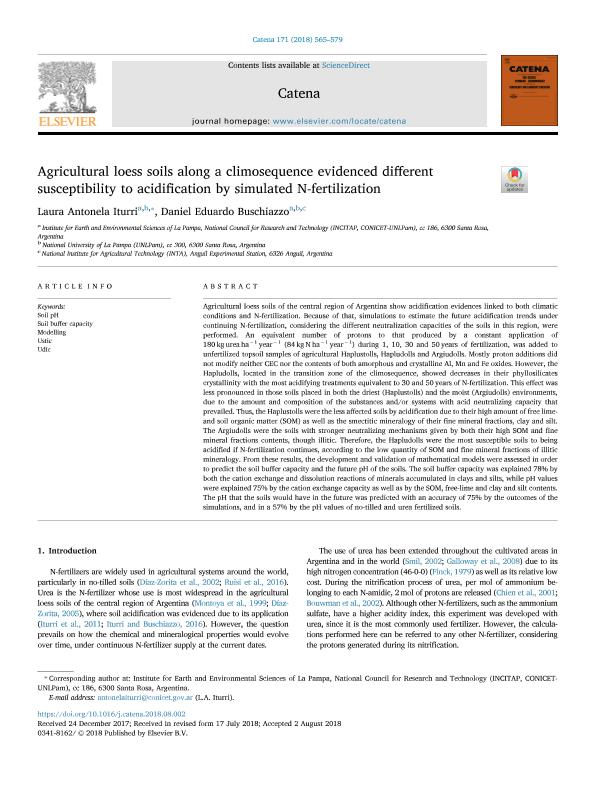Mostrar el registro sencillo del ítem
dc.contributor.author
Iturri, Laura Antonela

dc.contributor.author
Buschiazzo, Daniel Eduardo

dc.date.available
2019-08-12T15:54:57Z
dc.date.issued
2018-12
dc.identifier.citation
Iturri, Laura Antonela; Buschiazzo, Daniel Eduardo; Agricultural loess soils along a climosequence evidenced different susceptibility to acidification by simulated N-fertilization; Elsevier Science; Catena; 171; 12-2018; 565-579
dc.identifier.issn
0341-8162
dc.identifier.uri
http://hdl.handle.net/11336/81425
dc.description.abstract
Agricultural loess soils of the central region of Argentina show acidification evidences linked to both climatic conditions and N-fertilization. Because of that, simulations to estimate the future acidification trends under continuing N-fertilization, considering the different neutralization capacities of the soils in this region, were performed. An equivalent number of protons to that produced by a constant application of 180 kg urea ha−1 year−1 (84 kg N ha−1 year−1) during 1, 10, 30 and 50 years of fertilization, was added to unfertilized topsoil samples of agricultural Haplustolls, Hapludolls and Argiudolls. Mostly proton additions did not modify neither CEC nor the contents of both amorphous and crystalline Al, Mn and Fe oxides. However, the Hapludolls, located in the transition zone of the climosequence, showed decreases in their phyllosilicates crystallinity with the most acidifying treatments equivalent to 30 and 50 years of N-fertilization. This effect was less pronounced in those soils placed in both the driest (Haplustolls) and the moist (Argiudolls) environments, due to the amount and composition of the substances and/or systems with acid neutralizing capacity that prevailed. Thus, the Haplustolls were the less affected soils by acidification due to their high amount of free lime- and soil organic matter (SOM) as well as the smectitic mineralogy of their fine mineral fractions, clay and silt. The Argiudolls were the soils with stronger neutralizing mechanisms given by both their high SOM and fine mineral fractions contents, though illitic. Therefore, the Hapludolls were the most susceptible soils to being acidified if N-fertilization continues, according to the low quantity of SOM and fine mineral fractions of illitic mineralogy. From these results, the development and validation of mathematical models were assessed in order to predict the soil buffer capacity and the future pH of the soils. The soil buffer capacity was explained 78% by both the cation exchange and dissolution reactions of minerals accumulated in clays and silts, while pH values were explained 75% by the cation exchange capacity as well as by the SOM, free-lime and clay and silt contents. The pH that the soils would have in the future was predicted with an accuracy of 75% by the outcomes of the simulations, and in a 57% by the pH values of no-tilled and urea fertilized soils.
dc.format
application/pdf
dc.language.iso
eng
dc.publisher
Elsevier Science

dc.rights
info:eu-repo/semantics/openAccess
dc.rights.uri
https://creativecommons.org/licenses/by-nc-sa/2.5/ar/
dc.subject
Modelling
dc.subject
Soil Buffer Capacity
dc.subject
Soil Ph
dc.subject
Udic
dc.subject
Ustic
dc.subject.classification
Agricultura

dc.subject.classification
Agricultura, Silvicultura y Pesca

dc.subject.classification
CIENCIAS AGRÍCOLAS

dc.title
Agricultural loess soils along a climosequence evidenced different susceptibility to acidification by simulated N-fertilization
dc.type
info:eu-repo/semantics/article
dc.type
info:ar-repo/semantics/artículo
dc.type
info:eu-repo/semantics/publishedVersion
dc.date.updated
2019-08-09T14:32:19Z
dc.journal.volume
171
dc.journal.pagination
565-579
dc.journal.pais
Países Bajos

dc.journal.ciudad
Amsterdam
dc.description.fil
Fil: Iturri, Laura Antonela. Consejo Nacional de Investigaciones Científicas y Técnicas. Instituto de Ciencias de la Tierra y Ambientales de La Pampa. Universidad Nacional de La Pampa. Facultad de Ciencias Exactas y Naturales. Instituto de Ciencias de la Tierra y Ambientales de La Pampa; Argentina
dc.description.fil
Fil: Buschiazzo, Daniel Eduardo. Consejo Nacional de Investigaciones Científicas y Técnicas. Instituto de Ciencias de la Tierra y Ambientales de La Pampa. Universidad Nacional de La Pampa. Facultad de Ciencias Exactas y Naturales. Instituto de Ciencias de la Tierra y Ambientales de La Pampa; Argentina. Instituto Nacional de Tecnología Agropecuaria. Centro Regional La Pampa-San Luis. Estación Experimental Agropecuaria Anguil; Argentina
dc.journal.title
Catena

dc.relation.alternativeid
info:eu-repo/semantics/altIdentifier/url/https://www.sciencedirect.com/science/article/pii/S0341816218303266
dc.relation.alternativeid
info:eu-repo/semantics/altIdentifier/doi/https://doi.org/10.1016/j.catena.2018.08.002
Archivos asociados
